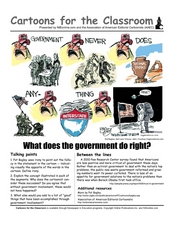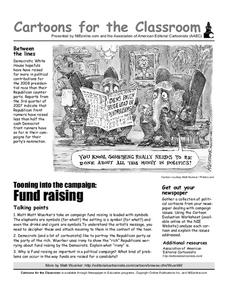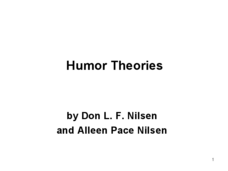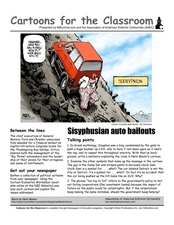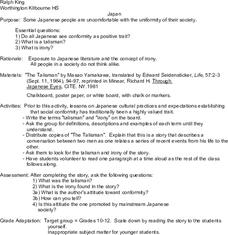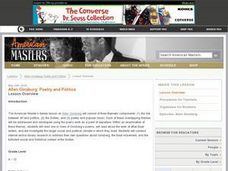Curated OER
Cartoons for the Classroom: Sarcasm, Irony, and Satire
Satire, sarcasm, or irony? Editorial cartoons have long been the tool artists use to express their opinions about politics and politicians. Kevin "Kai" Kallaugher's four-panel cartoon offers readers an opportunity to examine how he uses...
Curated OER
Irony
Using examples from Socrates to Johnny Carson, this slideshow presents your students with the history and definition of dramatic irony, satire, situational irony, and tragic irony. This presentation would be useful in a language arts...
Curated OER
Creating Civic Awareness Through Artistic and Literary Forms
Interpret current events using editorial cartoons and other print media. Middle schoolers explore the meanings of literary and artistic terms such as satire, irony, and caricature. They visit internet sites to develop an understanding of...
Curated OER
Cartoons for the Classroom: What's Next in 2011?
Examine the toolbox of political cartoons with this analysis handout, which features a cartoon utilizing satire, sarcasm, and irony as it predicts the current events of 2011. Interestingly, this will also serve to get scholars looking...
Curated OER
Cartoons for the Classroom: Social Commentary
Expose your class to the genre of political cartoons less concerned with serious political issues. This political cartoon analysis handout features social commentary on the many entertainments of youth, ironically paired with their...
Curated OER
What Does the Government Do Right?
Challenge your class to reevaluate preconceived notions about government with this political cartoon analysis. An image presents a clear example of irony, in which a disgruntled American complains about his government, yet fails to see...
Curated OER
Cartoons for the Classroom: Campaign Fundraising
Although this political cartoon analysis assignment has your scholars glancing back at the 2008 presidential campaign, its message is relatable anytime. Background information provides context, giving learners access to the cartoon,...
Curated OER
Sarcasm
Learners often regard sarcasm as a "you know it when you see it" language phenomenon, leading to confusing tone and humor in student writing. This presentation not only defines sarcasm (and irony) in plain terms, it also provides many...
Curated OER
Humor Theories
Providing ample examples of humor in literature, psychology, and sociology, this presentation studies the concept and function of humor in society today. Covering what is classically "funny" and what is not, and why, the slideshow will...
Curated OER
Slices of American Pie: The 1960s Through Music
Eleventh graders examine political, cultural, and social movements through music. In this 1960s American history lesson plan, 11th graders explore the music of the decade in order to better understand the complexity of the time period....
Curated OER
"Big Three" Bailouts
What does your class think about big business bailouts by the U.S. Government? Find out with this activity, where learners analyze a political cartoon comparing the "Big Three" automakers with the Greek Myth of Sisyphus. Background...
Curated OER
Japan
Students read the literature of The Talisman in order to make cultural connections and investigate the concept of irony and how it is used in this Japanese text. They also discuss the issue of conformity and its relationship to the story.
Curated OER
Editorial Cartoons: A Historical Example of Immigration Debates
Eleventh graders analyze political cartoons. In this American History lesson, 11th graders research the Chinese Exclusion Act and the current arguments about immigration to the United States. Students create a graphic...
Curated OER
Beyond Chopsticks and Rice
Students explore the stereotypical American images of China. In this English and World History lesson, students read a novel to become familiar with China and its people. Students research various events in China's history and report...
Curated OER
Energy Crisis: Then and Now
Using political cartoons, scholars analyze the energy crisis of the 1970s and '80s, comparing and contrasting it to current tensions with oil. Display the 6 cartoons (linked) to the class, and demonstrate analysis using the worksheet...
Curated OER
Voices of Tragedy and Horror: Remembering the Holocaust
Students consider the implications of the Holocaust. In this World War II lesson, students read the graphic novel Maus at the end of a unit on World War II. Students discuss the impact of reading about the Holocaust as well as theme of...
Curated OER
Rural Life During the Great Depression: A Year Down Yonder
“Anyone who thinks small towns are friendlier than big cities lives in a big city.” Mary Alice, the fifteen-year-old narrator of A Year Down Yonder, is forced to leave Chicago and spend a year with her Grandma Dowdel in a small rural...
Curated OER
Allen Ginsberg: Poetry and Politics
Learners explore the poetry of Allen Ginsberg. They read and analyze poems by Allen Ginsberg, conduct Internet research, collect examples of art of the 60s, and create a presentation.
Curated OER
A New Look at Romeo and Juliet
Students explore life and language development in the Elizabethan Age. In this English instructional activity students complete web-quests and other activities surrounding Shakespeare's Romeo and Juliet.





